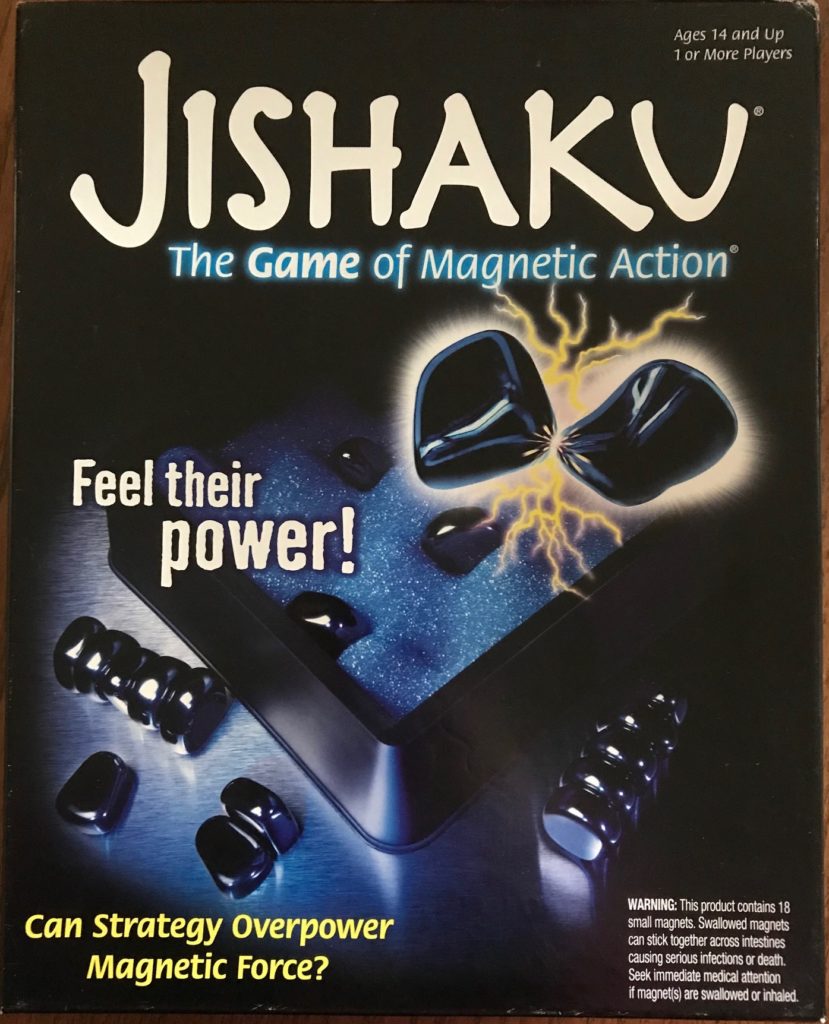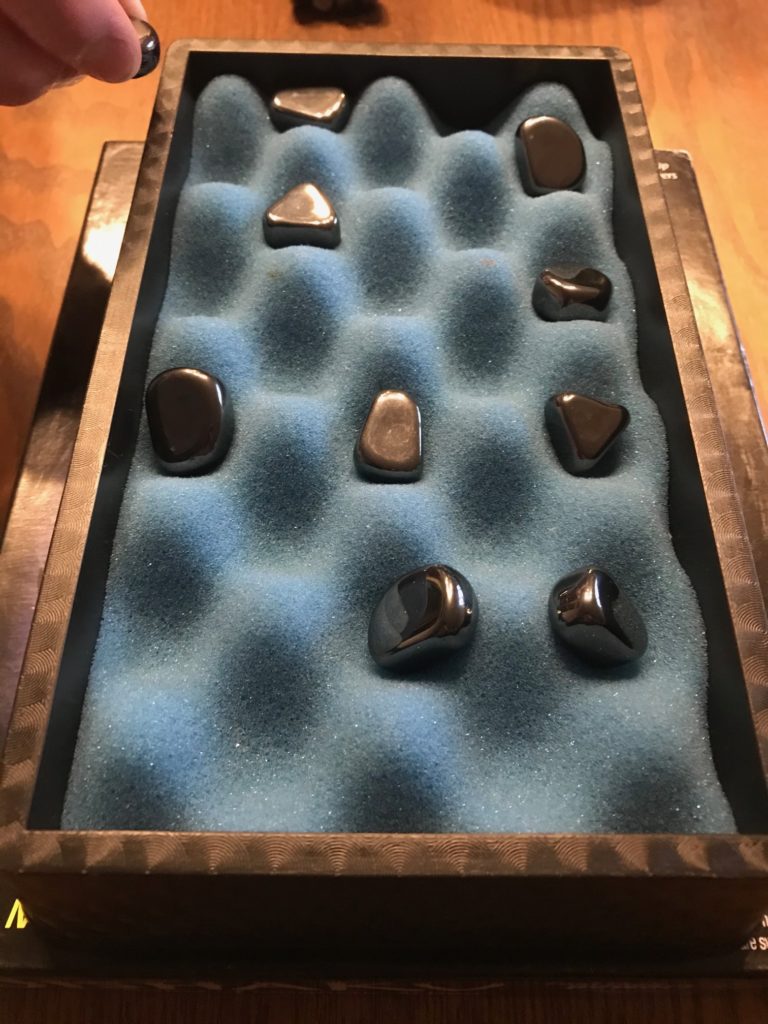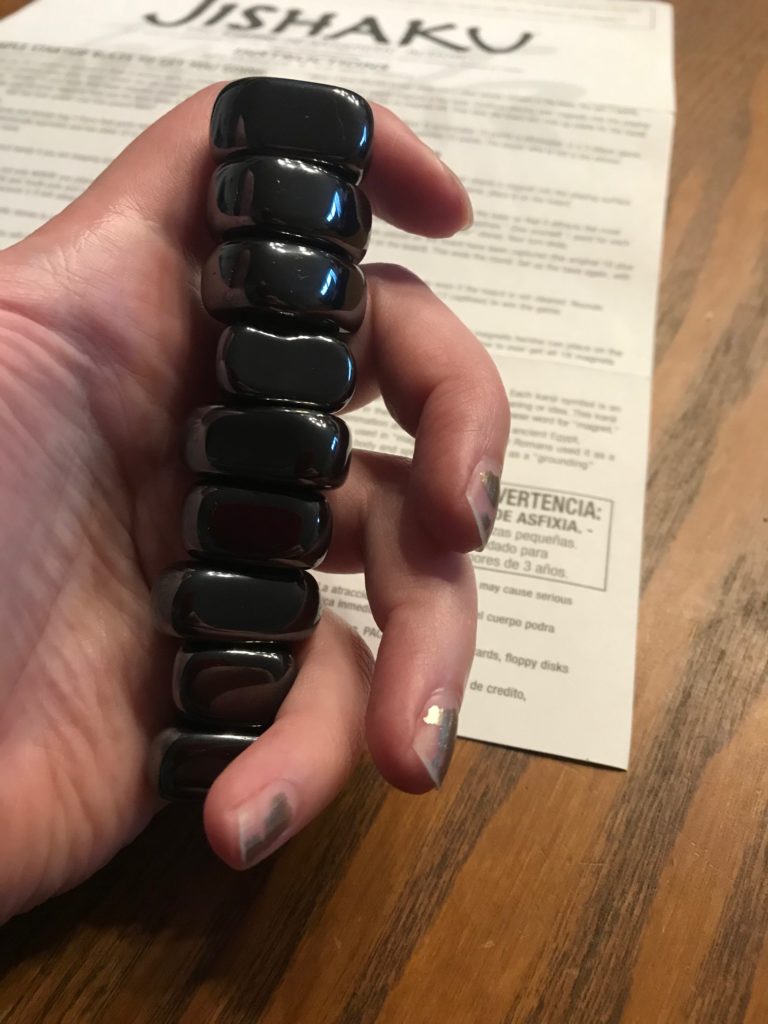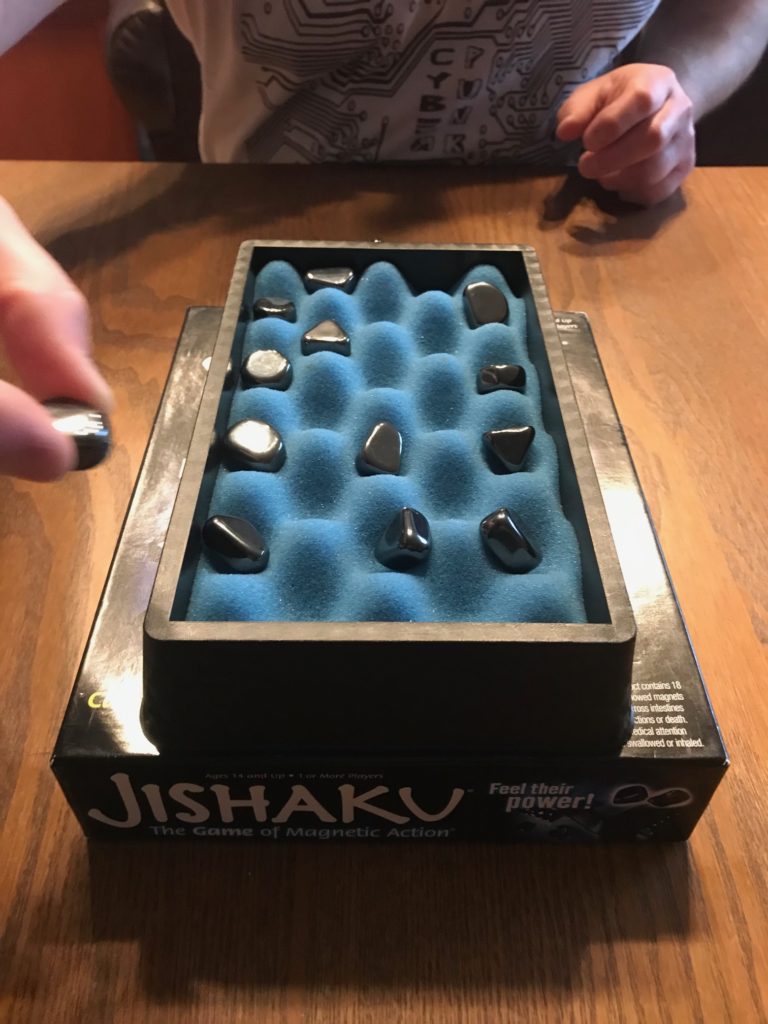Review: Jishaku
Publisher: RSV Productions, Inc.
Year: 2007
Players: 1 or more
Tagline: The Game of Magnetic Action

how we met
Jishaku is probably one of the last games I picked up at thrift before we locked down at home. It’s definitely illustrative of the random games we find at one of the local thrift shops. Prices are always $2. You might find XCOM, you might find Jishaku. You might find Can’t Stop, you might find Gargoyles. You might find Battleball, you might find Harassment The Game. You might find nothing.
These are all true stories, but the point is that one day I found Jishaku at my local thrift shop. The game looked strange and magnetic. I am often intimidated by abstract games. I am just not sure I have the attention span to be successful at them. But abstract games also come in all shapes and sizes, and they often interest me. I was excited to check Jishaku out.
how it plays
Jishaku consists of 18 rather strong magnetic stones and a foam playing field with (in my version) 22 spaces to place a stone. The winning conditions depend upon which version you decide to play.

Jishaku does a nice job with their instructions, and they provide multiple ways to play. The rules outline the strategy of the game, which probably can’t be overstated: It is important where you place your stone as well as how you place your stone.
There are four games offered in the instructions:
- I’m Out! – I would consider this version a default since it is emphasized a bit in the rules. Split the stones between the players and take turns placing one stone at a time in the playing field. If one or more stones attach to yours or any others during your turn, add those to your hand. The first player to declare they are out of stones to place wins I’m Out!
- Elimination – this version seems very similar to I’m Out! except that you get points whenever stones get attached. The first player to 10 points is eliminated. If you have more players keep playing until a last player is left, and they win Elimination!
- Roundup – this version sounds fun because the goal is to place ten stones as a team prior to starting play. Then on your turn place one of your remaining stones with the goal of attracting as many other stones as you can. So this version flips and makes attracting stones a positive. Take one point for each stone you attract. First player to 12 points wins!
- Solitaire – this version is very simple. You are alone with 18 magnetic stones and 22 foam holes. See how many stones you can place without any connecting. Very few can place all 18!
how it went
Bill and I played Jishaku recently on a rainy Saturday afternoon. We played the I’m Out! version before just randomly playing with and testing our magnets. Although Jishaku provides four different versions of gameplay, I’m Out! and Elimination are essentially the same. Roundup is even more dependent upon who goes first. And Solitaire seems challenging and fine.

These magnetic stones are very strong. Before we started play Bill was noticing the stones reacting to their surroundings, most likely some screw or other metal bit in the underside of our ancient dining room table. In order to minimize any disruption we put the playing area on top of the box to extend the distance between our magnetic stones and the underside of the table.
So we all know the basics of magnets, right? They have north and south poles. The opposite poles attract each other and the same poles repel each other. When you have stones that are magnetic, it’s not always clear where those poles are unless you are able to test them out in advance.
You will never know (unless something happens to give it away) how your opponent is placing their stone from a magnetic perspective. The best you can do is use the other magnets in your hand to understand the basics of the stone you are placing, then pay attention to how any surrounding stones react. And trust me, they react.
You can try to place your stones so that the strong side faces down, but that only works for magnets whose poles are lined up according to your inner knowledge. If we have the same “stick” of eight or nine magnets and mine is facing one way while yours is facing another we may be on two opposite pages as we place stones.

There are some fun and clever reviews of Jishaku on BGG. BGG user @robertlahue even went to the trouble of measuring the distance at which the stones will generally react to one another, with the ultimate conclusion that the playing board makes certain placements near impossible. I understand one of the responses to this review too: the game is supposed to be challenging.
The distance from which the stones will almost inevitably react is where you need to try and force your opponent to place. But even if you get to really know what you are doing, your success seems to depend a great deal on whether or not you went first.
BGG user @rjbeeth seems to be a fan of the game but suggests buying more magnets will make it so that the first person to make a mistake is not necessarily the loser. That makes a lot of sense.
What I enjoyed most about Jishaku was the tension. The magnets are strong, so waiting to see if they jump together feels very tense. Will they pinch my fingers? So exciting!

I had a pretty big oops at some point in our play and it gave Bill enough runway to be able to place every stone he had left before I could really do anything about it. And Bill won Jishaku!
play or pass
Pass. I might actually encourage you to pick up Jishaku if you see it at thrift because it’s so unique. The gameplay is simple and I do enjoy the tension. But Jishaku dared to ask the question: can strategy overpower magnetic force? The answer in our play was no. Once the board hits a critical mass of stones, there’s no real safe placement and you can’t recover. The magnets win every time.